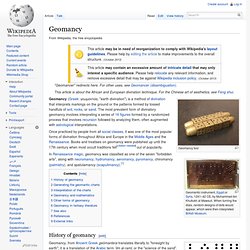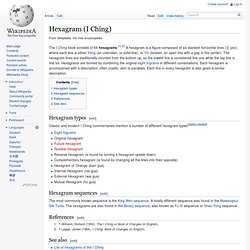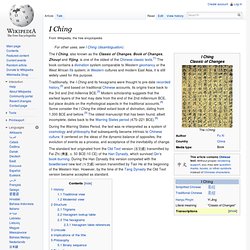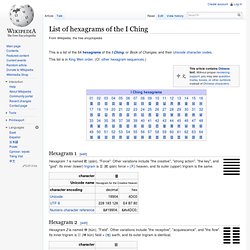

Geomancy. Geomancy tool Geomantic instrument, Egypt or Syria, 1241–42 CE, by Muhammad ibn Khutlukh al Mawsuli.

When turning the dials, random designs of dots would appear, which were then interpreted. British Museum. Geomancy (Greek: γεωμαντεία, "earth divination") is a method of divination that interprets markings on the ground or the patterns formed by tossed handfuls of soil, rocks, or sand. The most prevalent form of divinatory geomancy involves interpreting a series of 16 figures formed by a randomized process that involves recursion followed by analyzing them, often augmented with astrological interpretations. Once practiced by people from all social classes, it was one of the most popular forms of divination throughout Africa and Europe in the Middle Ages and the Renaissance. In Renaissance magic, geomancy was classified as one of the seven "forbidden arts", along with necromancy, hydromancy, aeromancy, pyromancy, chiromancy (palmistry), and spatulamancy (scapulimancy).[1] A shield chart.
Hexagram (I Ching) The I Ching book consists of 64 hexagrams.[1] [2] A hexagram is a figure composed of six stacked horizontal lines (爻 yáo), where each line is either Yang (an unbroken, or solid line), or Yin (broken, an open line with a gap in the center).

The hexagram lines are traditionally counted from the bottom up, so the lowest line is considered line one while the top line is line six. Hexagrams are formed by combining the original eight trigrams in different combinations. Each hexagram is accompanied with a description, often cryptic, akin to parables. Each line in every hexagram is also given a similar description. Classic and modern I Ching commentaries mention a number of different hexagram types[citation needed]: The most commonly known sequence is the King Wen sequence. Jump up ^ Wilhelm, Richard (1950). I Ching. The I Ching, also known as the Classic of Changes, Book of Changes, Zhouyi and Yijing, is one of the oldest of the Chinese classic texts.[1] The book contains a divination system comparable to Western geomancy or the West African Ifá system; in Western cultures and modern East Asia, it is still widely used for this purpose.

Traditionally, the I Ching and its hexagrams were thought to pre-date recorded history,[2] and based on traditional Chinese accounts, its origins trace back to the 3rd and 2nd millennia BCE.[3] Modern scholarship suggests that the earliest layers of the text may date from the end of the 2nd millennium BCE, but place doubts on the mythological aspects in the traditional accounts.[4] Some consider the I Ching the oldest extant book of divination, dating from 1,000 BCE and before.[5] The oldest manuscript that has been found, albeit incomplete, dates back to the Warring States period (475–221 BCE).[6] History[edit] Traditional view[edit] Modernist view[edit] List of hexagrams of the I Ching. This list is in King Wen order.

(Cf. other hexagram sequences.) Hexagram 1[edit] Hexagram 1 is named 乾 (qián), "Force". Other variations include "the creative", "strong action", "the key", and "god". Its inner (lower) trigram is ☰ (乾 qián) force = (天) heaven, and its outer (upper) trigram is the same. Hexagram 2[edit] Hexagram 2 is named 坤 (kūn), "Field". Hexagram 3[edit] Hexagram 4[edit] Hexagram 5[edit] Hexagram 6[edit] Hexagram 7[edit] Hexagram 7 is named 師 (shī), "Leading". Hexagram 8[edit] Hexagram 9[edit] Hexagram 9 is named 小畜 (xiǎo chù), "Small Accumulating".
Hexagram 10[edit] Hexagram 10 is named 履 (lǚ), "Treading". Hexagram 11[edit] Hexagram 11 is named 泰 (tài), "Pervading". Hexagram 12[edit] Hexagram 12 is named 否 (pǐ), "Obstruction".